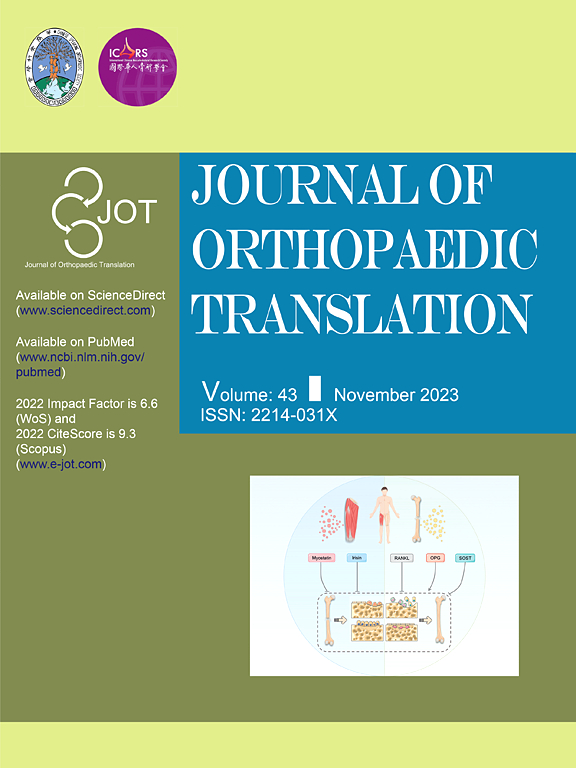Chk2缺失通过调节Cyp1a1来挽救Bmi1缺乏引起的骨质流失和细胞衰老
IF 5.9
1区 医学
Q1 ORTHOPEDICS
引用次数: 0
摘要
背景/目的由成骨细胞骨形成和破骨细胞骨吸收之间的平衡维持的骨稳态在骨质疏松症中被破坏,导致骨量减少和骨折风险增加。Bmi1是一种多梳蛋白,对干细胞的自我更新和衰老调控至关重要。Bmi1缺乏与氧化应激、DNA损伤和过早骨质疏松症有关。检查点激酶2 (Chk2)是DNA损伤反应(DDR)途径的关键介质,可通过氧化应激和衰老加剧骨老化。本研究探讨了Chk2缺失在减轻Bmi1缺乏症引起的骨质流失和细胞衰老中的作用,并探讨了其潜在的分子机制,重点研究了Cyp1a1对氧化应激的调节。方法采用Bmi1缺失(Bmi1−/−)、Chk2缺失(Chk2−/−)和双敲除(Bmi1−/−Chk2−/−)小鼠评估骨稳态。骨密度(BMD)、骨小梁结构和骨转换标志物通过x线成像、显微ct、组织学染色和骨组织形态测量进行评估。氧化应激标志物、DDR通路激活和衰老相关分泌表型(SASP)采用Western blotting、免疫组织化学和实时荧光定量PCR进行分析。转录组测序鉴定了包括Cyp1a1在内的差异表达基因,并通过染色质免疫沉淀(ChIP)、荧光素酶测定和骨髓间充质干细胞(BMSCs)的敲低实验进一步验证了这一点。结果bmi1缺乏激活ATM-Chk2-p53 DDR通路,增加氧化应激,诱导骨细胞衰老和衰老相关分泌表型(SASP),导致成骨细胞骨形成减少,破骨细胞骨吸收增加,骨质流失明显。敲除Chk2通过减少氧化应激和衰老来挽救这些缺陷。与Bmi1−/−Chk2−/−小鼠相比,BMD、骨小梁体积、胶原沉积和成骨细胞标志物(Runx2和OPN)显著改善,而破骨细胞标志物(TRAP和RANKL/OPG比率)降低。氧化应激标志物SOD1和SOD2恢复,衰老标志物p16、p21和β-gal活性显著降低。转录组分析发现Cyp1a1是Bmi1和Chk2下游氧化应激的关键调节因子。Bmi1缺乏上调Cyp1a1,增加ROS水平,而Chk2敲除下调Cyp1a1,减轻氧化应激。在机制上,p53被证明直接结合Cyp1a1启动子并激活其转录,Chk2敲除可降低p53介导的Cyp1a1表达。这些发现强调了Bmi1-Chk2-p53-Cyp1a1轴在调节骨稳态中的关键作用。结论chk2基因敲除可通过下调Cyp1a1基因表达减少氧化应激,从而缓解Bmi1缺乏症引起的骨质流失和细胞衰老。这些发现为骨老化的分子机制提供了新的见解,并确定Chk2和Cyp1a1是骨质疏松症和年龄相关骨疾病的潜在治疗靶点。本研究确定Chk2和Cyp1a1是骨质疏松症和年龄相关性骨质流失的潜在治疗靶点。靶向Chk2或Cyp1a1可以减轻氧化应激和细胞衰老,为老年人保存骨量和预防骨折提供了新的方法。本文章由计算机程序翻译,如有差异,请以英文原文为准。

Chk2 deletion rescues bone loss and cellular senescence induced by Bmi1 deficiency via regulation of Cyp1a1
Background/objective
Bone homeostasis, maintained by a balance between osteoblastic bone formation and osteoclastic bone resorption, is disrupted in osteoporosis, leading to reduced bone mass and increased fracture risk. Bmi1, a polycomb group protein, is crucial for stem cell self-renewal and senescence regulation. Bmi1 deficiency has been linked to oxidative stress, DNA damage, and premature osteoporosis. Checkpoint kinase 2 (Chk2) is a key mediator of the DNA damage response (DDR) pathway, which can exacerbate bone aging through oxidative stress and senescence. This study investigated the role of Chk2 deletion in mitigating bone loss and cellular senescence caused by Bmi1 deficiency and explored the underlying molecular mechanisms, focusing on the regulation of oxidative stress via Cyp1a1.
Methods
We utilized Bmi1-deficient (Bmi1−/−), Chk2-deficient (Chk2−/−), and double knockout (Bmi1−/−Chk2−/−) mice to assess bone homeostasis. Bone mineral density (BMD), trabecular architecture, and bone turnover markers were evaluated using X-ray imaging, micro-CT, histological staining, and bone histomorphometry. Oxidative stress markers, DDR pathway activation, and senescence-associated secretory phenotype (SASP) were analyzed using Western blotting, immunohistochemistry, and real-time PCR. Transcriptome sequencing identified differentially expressed genes, including Cyp1a1, which was further validated through chromatin immunoprecipitation (ChIP), luciferase assays, and knockdown experiments in bone marrow mesenchymal stem cells (BMSCs).
Results
Bmi1 deficiency activated the ATM-Chk2-p53 DDR pathway, increased oxidative stress, and induced osteocyte senescence and senescence-associated secretory phenotype (SASP), leading to reduced osteoblastic bone formation, increased osteoclastic bone resorption, and significant bone loss. Chk2 knockout rescued these defects by reducing oxidative stress and senescence. In Bmi1−/−Chk2−/− mice, BMD, trabecular bone volume, collagen deposition, and osteoblast markers (Runx2 and OPN) were significantly improved, while osteoclast markers (TRAP and RANKL/OPG ratio) were reduced compared to Bmi1−/− mice. Oxidative stress markers, including SOD1 and SOD2, were restored, and senescence markers such as p16, p21, and β-gal activity were significantly decreased. Transcriptome analysis identified Cyp1a1 as a key regulator of oxidative stress downstream of Bmi1 and Chk2. Bmi1 deficiency upregulated Cyp1a1, increasing ROS levels, while Chk2 knockout downregulated Cyp1a1 and mitigated oxidative stress. Mechanistically, p53 was shown to directly bind the Cyp1a1 promoter and activate its transcription, with Chk2 knockout reducing p53-mediated Cyp1a1 expression. These findings highlight the critical role of the Bmi1-Chk2-p53-Cyp1a1 axis in regulating bone homeostasis.
Conclusion
Chk2 knockout rescues bone loss and cellular senescence induced by Bmi1 deficiency by reducing oxidative stress through downregulation of Cyp1a1. These findings provide novel insights into the molecular mechanisms underlying bone aging and identify Chk2 and Cyp1a1 as potential therapeutic targets for osteoporosis and age-related bone disorders.
The translational potential of this article
This study identifies Chk2 and Cyp1a1 as potential therapeutic targets for osteoporosis and age-related bone loss. Targeting Chk2 or Cyp1a1 could mitigate oxidative stress and cellular senescence, offering a novel approach to preserving bone mass and preventing fractures in aging populations.
求助全文
通过发布文献求助,成功后即可免费获取论文全文。
去求助
来源期刊

Journal of Orthopaedic Translation
Medicine-Orthopedics and Sports Medicine
CiteScore
11.80
自引率
13.60%
发文量
91
审稿时长
29 days
期刊介绍:
The Journal of Orthopaedic Translation (JOT) is the official peer-reviewed, open access journal of the Chinese Speaking Orthopaedic Society (CSOS) and the International Chinese Musculoskeletal Research Society (ICMRS). It is published quarterly, in January, April, July and October, by Elsevier.
 求助内容:
求助内容: 应助结果提醒方式:
应助结果提醒方式:


